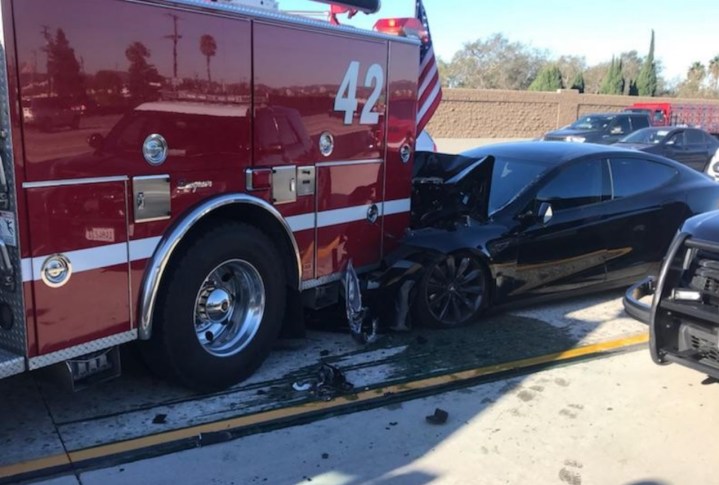
The accident happened in Culver City on Interstate 405. The fire truck was stopped in the left emergency and carpool lanes to block off an earlier accident, according to San Jose-based Mercury News. The Model S — whose driver hasn’t been identified yet — slammed into the back of the truck at about 65 mph. Its low front end slid under the truck, crumpling the hood. The passenger compartment looks virtually intact and, astoundingly, there were no injuries. The driver refused medical attention.
“It was a pretty big hit,” Culver City Fire Department battalion chief Ken Powell reported. He added there was a CHP vehicle parked behind the truck and another one right next to it. Both had their emergency lights flashing so the driver should have seen them — and, presumably, the truck — well before the crash, which happened at 8:30 a.m. on a sunny day. Autopilot should have detected the vehicles, too, and either slowed the car down or asked the driver to take over. It may not be the computer’s fault, though.
Autopilot is “intended for use only with a fully attentive driver,” Tesla pointed out in a statement sent to Bloomberg. It again stressed that, despite its name, the technology does not make the Model S fully autonomous and the driver needs to remain alert at all times. As of writing, the CHP hasn’t been able to verify whether the vehicle was indeed traveling on Autopilot at the time of the accident. We expect Tesla will examine the vehicle’s data logs in the coming days to shed light into precisely what happened.
The crash inevitably caught the attention of the National Transportation Safety Board (NTSB), according to Bloomberg. It’s currently gathering information about the circumstances of the accident. NTSB spokesman Chris O’Neil said the agency will open a formal investigation as it did in 2016 when a Model S, also on Autopilot, drove right under a semi trailer it didn’t detect, killing the driver.
Editors' Recommendations
- The BMW i4 is more luxurious than the Tesla Model S, and costs way less
- Watch Elon Musk’s high-speed start to Tesla’s Model S Plaid delivery event
- Elon Musk suggests Autopilot was off in fatal Texas Tesla crash
- A gaming Tesla? New Model S to use same GPU as PlayStation 5 and Xbox Series X
- Tesla gives the Model S over 1,000 hp and a spaceship-like steering wheel




